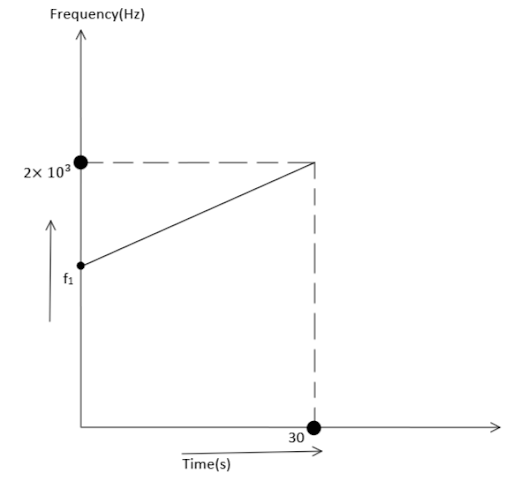
A source of sound of frequency ${f_1}$ is placed on the ground. A detector placed at a height is released from rest on this source. The observed frequency $f(Hz)$ is plotted against time $t(\sec )$ . The speed of sound in air is $300\,m/s$ . Find ${f_1}$ $\left( {g = 10m/{s^2}} \right)$ .

A. $0.5 \times {10^3}\,Hz$
B. $1 \times {10^3}\,Hz$
C. $0.25 \times {10^3}\,Hz$
D. $0.2 \times {10^3}\,Hz$
Answer
216k+ views
Hint: In such a case, the solution to a problem is trickier that’s why we have to use a different approach to solve the question. This problem is based on sound waves, we know that the frequency of a wave varies with different parameters hence, we will try to solve this problem by calculating the slope of the graph.
Formula used:
The expression of apparent frequency is,
$f = {f_1}\left( {\dfrac{{v + {v_0}}}{v}} \right) = {f_1} + \dfrac{{{v_0}}}{v}{f_1}$
Where, $f_1$ is the source frequency, $v_0$ is the speed of the observer and $v$ is the speed of sound in air.
Complete step by step solution:
The speed of sound in air is $v = 300m/s$....(given)
The observer frequency $f = 2 \times {10^3}Hz$ is taken from the graph given.
Now, we know that Apparent frequency of observer will be:
$f = {f_1}\left( {\dfrac{{v + {v_0}}}{v}} \right) = {f_1} + \dfrac{{{v_0}}}{v}{f_1}$… (1)
Using 1st Equation of motion, we have ${v_0} = gt$
where, $g = 10m/{s^2}$ = Acceleration due to gravity (given)
From (1), we get
$f - {f_1} = \left( {\dfrac{{{f_1}g}}{v}} \right)t$
where, $\dfrac{{{f_1}g}}{v}$ = Slope of the given graph
The above expression can also be written as:
$\dfrac{{f - {f_1}}}{t} = \dfrac{{{f_1}g}}{v}$ … (2)
Substituting all the value given in the question in eq. (2) at time $t = 30\,s$, we get
$\dfrac{{2 \times {{10}^3} - {f_1}}}{{30}} = \dfrac{{{f_1} \times 10}}{{300}} \\ $
$ \therefore {f_1} = 1 \times {10^3}Hz$
Thus, the frequency of a source of sound is $1 \times {10^3}Hz$.
Hence, the correct option is B.
Note: The Doppler effect is a significant phenomena in many scientific areas, including planetary science. The Doppler effect, often known as the Doppler shift, explains variations in the frequency of any sound or light wave produced by a moving source in relation to an observer.
Formula used:
The expression of apparent frequency is,
$f = {f_1}\left( {\dfrac{{v + {v_0}}}{v}} \right) = {f_1} + \dfrac{{{v_0}}}{v}{f_1}$
Where, $f_1$ is the source frequency, $v_0$ is the speed of the observer and $v$ is the speed of sound in air.
Complete step by step solution:
The speed of sound in air is $v = 300m/s$....(given)
The observer frequency $f = 2 \times {10^3}Hz$ is taken from the graph given.
Now, we know that Apparent frequency of observer will be:
$f = {f_1}\left( {\dfrac{{v + {v_0}}}{v}} \right) = {f_1} + \dfrac{{{v_0}}}{v}{f_1}$… (1)
Using 1st Equation of motion, we have ${v_0} = gt$
where, $g = 10m/{s^2}$ = Acceleration due to gravity (given)
From (1), we get
$f - {f_1} = \left( {\dfrac{{{f_1}g}}{v}} \right)t$
where, $\dfrac{{{f_1}g}}{v}$ = Slope of the given graph
The above expression can also be written as:
$\dfrac{{f - {f_1}}}{t} = \dfrac{{{f_1}g}}{v}$ … (2)
Substituting all the value given in the question in eq. (2) at time $t = 30\,s$, we get
$\dfrac{{2 \times {{10}^3} - {f_1}}}{{30}} = \dfrac{{{f_1} \times 10}}{{300}} \\ $
$ \therefore {f_1} = 1 \times {10^3}Hz$
Thus, the frequency of a source of sound is $1 \times {10^3}Hz$.
Hence, the correct option is B.
Note: The Doppler effect is a significant phenomena in many scientific areas, including planetary science. The Doppler effect, often known as the Doppler shift, explains variations in the frequency of any sound or light wave produced by a moving source in relation to an observer.
Recently Updated Pages
JEE Atomic Structure and Chemical Bonding important Concepts and Tips

JEE Amino Acids and Peptides Important Concepts and Tips for Exam Preparation

Electricity and Magnetism Explained: Key Concepts & Applications

Chemical Properties of Hydrogen - Important Concepts for JEE Exam Preparation

JEE Energetics Important Concepts and Tips for Exam Preparation

JEE Isolation, Preparation and Properties of Non-metals Important Concepts and Tips for Exam Preparation

Trending doubts
JEE Main Correction Window 2026 Session 1 Dates Announced - Edit Form Details, Dates and Link

Atomic Structure: Definition, Models, and Examples

Ideal and Non-Ideal Solutions Explained for Class 12 Chemistry

Degree of Dissociation: Meaning, Formula, Calculation & Uses

Understanding Electromagnetic Waves and Their Importance

Geostationary and Geosynchronous Satellites Explained

Other Pages
Inertial and Non-Inertial Frame of Reference Explained

Clemmensen and Wolff Kishner Reductions Explained for JEE & NEET

JEE Main 2023 January 29th Shift 2 Physics Question Paper with Answer Keys and Solutions

Current Loop as a Magnetic Dipole: Concept, Derivation, and Examples

Two identical balls are projected one vertically up class 11 physics JEE_MAIN

NCERT Solutions For Class 11 Physics Chapter 13 Oscillations - 2025-26




